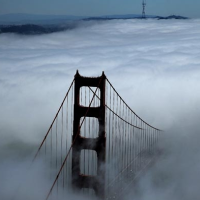Nearly One Golden Gate Bridge Suicide a Week as Plans for Safety Barrier Drag On
 North tower of the Golden Gate Bridge (photo: Justin Sullivan, Getty Images)
North tower of the Golden Gate Bridge (photo: Justin Sullivan, Getty Images)
The original design for San Francisco’s Golden Gate Bridge, which opened 76 years ago, included a safety rail 5-feet, 6-inches high. The final design lowered that to 4 feet and people have been jumping off the bridge ever since—around 1,600 confirmed to date, according to the Bridge Rail Foundation.
On Monday, the watchdog group announced that 46 people leaped to their death in 2013 and reiterated its call to execute safety designs that have been on the drawing board since 2008. While the foundation received a splash of publicity for its effort, the bridge’s dismal safety history is one of public outrage followed by rising expectations and dashed hopes.
According to a history on the foundation website, the first suicide occurred within weeks of the bridge’s opening in 1937. By 1939, 11 people had jumped to their death and the California Highway Patrol (CHP) was raising an alarm. But it wasn’t until 1948 that a study was conducted and 1953 before a solution was proposed. Suicides continued unabated, averaging about two a month by 1962.
A blast of media coverage accompanied the 500th suicide in 1973 and during the decade 17 safety-barrier designs were reviewed in earnest, but none were executed. Government was spurred to action by the approaching 1,000th suicide in the mid-90s.
“They stopped counting,” according to the foundation. But phones connected to crisis counseling centers were installed on the 4,200-foot span and bridge personnel received new training. “A new design for the railing was examined, and a prototype was installed in the Bridge parking lot.”
The suicide count from year to year remained a bit hazy until 2005, when the Marin County coroner began reporting the body count. Within a year, the Metropolitan Transportation Commission released funds for another study of bridge safety and by 2008 had five preliminary designs. One of them incorporated a safety net, which won the backing of officials, and a final authorization for finishing that design was given in 2010.
Finding funding for the project, estimated at between $45 million and $66 million, is another matter. Neither the state nor federal government has volunteered to pony up the money.
An analysis of nine popular suicide spots, published in the International Journal of Epidemiology, found that those locations that installed barriers, safety nets and other preventive structures experienced an 86% reduction in jumping suicides per year. Unfortunately, jumpers went elsewhere and there was a 44% increase at nearby sites. But overall, jumping dropped a net 28%.
For those who would argue that jumpers are going to keep trying to kill themselves if denied a shot at the Golden Gate, the Bridge Rail Foundation counters with a claim that 90% of the 30 people who survived the leap did not go on to kill themselves. Reportedly, many of them said afterward they were sorry, while in mid-leap, that they had jumped.
Jumper Ken Baldwin told The New Yorker, “I instantly realized that everything in my life that I’d thought was unfixable was totally fixable—except for having just jumped.”
–Ken Broder
To Learn More:
Golden Gate Bridge Suicides Hit Record High—46 (by Vivian Ho, San Francisco Chronicle)
Golden Gate Bridge Hits Milestone in 2013 with 46 Suicides (by Alex Dobuzinskis, Reuters)
People Committed Suicide at Golden Gate Bridge Nearly Once a Week Last Year (by Lydia O'Connor, Huffington Post)
Don’t Jump: A Simple Fix to the Golden Gate Bridge Would Save Hundreds of Lives (by Liza Gross, Slate)
Jumpers: The Fatal Grandeur of the Golden Gate Bridge (by Tad Friend, The New Yorker)
- Top Stories
- Controversies
- Where is the Money Going?
- California and the Nation
- Appointments and Resignations
- Unusual News
- Latest News
- California Forbids U.S. Immigration Agents from Pretending to be Police
- California Lawmakers Urged to Strip “Self-Dealing” Tax Board of Its Duties
- Big Oil’s Grip on California
- Santa Cruz Police See Homeland Security Betrayal in Use of Gang Roundup as Cover for Immigration Raid
- Oil Companies Face Deadline to Stop Polluting California Groundwater





